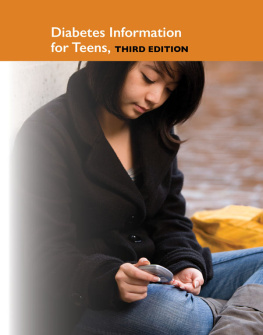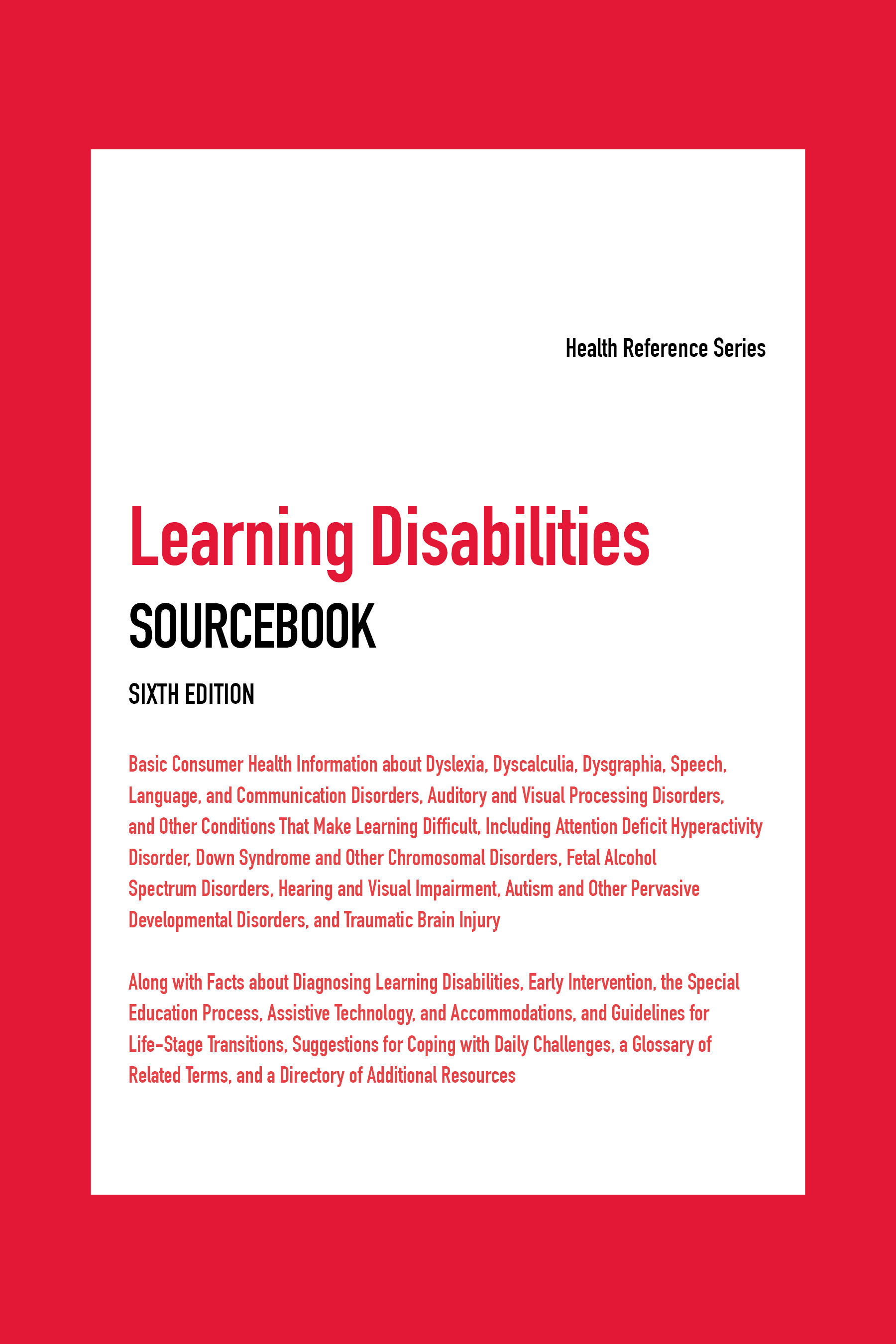Learning Disabilities
SOURCEBOOK
Sixth Edition
Health Reference Series
Learning Disabilities
SOURCEBOOK
Sixth Edition
Basic Consumer Health Information about Dyslexia, Dyscalculia, Dysgraphia, Speech, Language, and Communication Disorders, Auditory and Visual Processing Disorders, and Other Conditions That Make Learning Difficult, Including Attention Deficit Hyperactivity Disorder, Down Syndrome and Other Chromosomal Disorders, Fetal Alcohol Spectrum Disorders, Hearing and Visual Impairment, Autism and Other Pervasive Developmental Disorders, and Traumatic Brain Injury
Along with Facts about Diagnosing Learning Disabilities, Early Intervention, the Special Education Process, Assistive Technology, and Accommodations, and Guidelines for Life-Stage Transitions, Suggestions for Coping with Daily Challenges, a Glossary of Related Terms, and a Directory of Additional Resources

615 Griswold, Ste. 520, Detroit, MI 48226
Bibliographic Note
Because this page cannot legibly accommodate all the copyright notices, the Bibliographic Note portion of the Preface constitutes an extension of the copyright notice.
* * *
OMNIGRAPHICS
Angela L. Williams, Managing Editor
* * *
Copyright 2019 Omnigraphics
ISBN 978-0-7808-1703-6
E-ISBN 978-0-7808-1704-3
Library of Congress Cataloging-in-Publication Data
Names: Omnigraphics, Inc., issuing body.
Title: Learning disabilities sourcebook: basic consumer health information about dyslexia, dyscalculia, dysgraphia, speech and communication disorders, auditory and visual processing disorders, and other conditions that make learning difficult, including attention deficit hyperactivity disorder, Down syndrome and other chromosomal disorders, fetal alcohol spectrum disorders, hearing and visual impairment, autism and other pervasive developmental disorders, and traumatic brain injury; along with facts about diagnosing learning disabilities, early intervention, the special education process, legal protections, assistive technology, and accommodations, and guidelines for life-stage transitions, suggestions for coping with daily challenges, a glossary of related terms, and a directory of additional resources.
Description: Sixth Edition. | Detroit, MI: Omnigraphics, Inc., [2019] | Series: Health reference series | Angela L. Williams, Managing Editor--T.p. verso. | Includes bibliographical references and index.
Identifiers: LCCN 2019013874 (print) | LCCN 2019017485 (ebook) | ISBN 9780780817043 (ebook) | ISBN 9780780817036 (hardcover: alk. paper)
Subjects: LCSH: Learning disabilities--United States--Handbooks, manuals, etc. | Learning disabled children--Education--United States--Handbooks, manuals, etc. | Learning disabled--Education--United States--Handbooks, manuals, etc. | Learning disabilities--United States--Diagnosis--Handbooks, manuals, etc.
Classification: LCC LC4705 (ebook) | LCC LC4705.L434 2019 (print) | DDC 371.90973--dc23
LC record available at https://lccn.loc.gov/2019013874
Electronic or mechanical reproduction, including photography, recording, or any other information storage and retrieval system for the purpose of resale is strictly prohibited without permission in writing from the publisher.
The information in this publication was compiled from the sources cited and from other sources considered reliable. While every possible effort has been made to ensure reliability, the publisher will not assume liability for damages caused by inaccuracies in the data, and makes no warranty, express or implied, on the accuracy of the information contained herein.

This book is printed on acid-free paper meeting the ANSI Z39.48 Standard. The infinity symbol that appears above indicates that the paper in this book meets that standard.
Printed in the United States
Preface
About This Book
Learning disabilities are neurological disorders that affect the brains ability to process, store, and communicate information. They are widespread, affecting as many as 1 out of every 5 people in the United States, according to the U.S. Department of Education. In 201516, the number of students between the ages of 3 and 21 receiving special education services was 6.7 million, or 13 percent of all public-school students. Among students receiving special education services, 34 percent had specific learning disabilities. Learning disabilities directly impact many areas in the lives of those affected, making school difficult, making it hard to obtain and sustain employment, making daily tasks challenging, and even affecting relationships. Yet, learning disabilities are invisible obstacles. For this reason, they are often misunderstood, and their impact is often underestimated.
Learning Disabilities Sourcebook, Sixth Edition provides information about dyslexia, dyscalculia, dysgraphia, speech and communication disorders, and auditory and visual processing disorders. It also provides details about other conditions that impact learning, including attention deficit hyperactivity disorder, autism and other pervasive developmental disorders, hearing and visual impairment, and Down syndrome and other chromosomal disorders. The book offers facts about diagnosing learning disabilities, the special education process, and legal protections. Guidelines for life-stage transitions and coping with daily challenges, a glossary of related terms, and a directory of resources for additional help and information are also included.
How to Use This Book
This book is divided into parts and chapters. Parts focus on broad areas of interest. Chapters are devoted to single topics within a part.
explains how the brain works, defines what learning disabilities are, and describes theories regarding their potential causes. It explains how learning disabilities are evaluated and provides tips on how to choose an evaluation professional.
describes the most common forms of learning disabilities, including problems with reading, writing, mathematics, speech, language, and communication. It explains what these disorders are, how they are diagnosed, and how they are treated. It also discusses learning disabilities among gifted students, a fairly commonbut often unrecognizedphenomenon.
discusses common disorders that have a component that affects a childs ability to learn, including attention deficit hyperactivity disorder; epilepsy; fetal alcohol spectrum disorders; pervasive developmental disorders; visual and hearing disabilities; and chromosomal disorders, such as Down syndrome.
provides information about how learning disabilities are accommodated within the schools. It describes early intervention strategies, explains how the special education process works, and details the legal supports for students with learning disabilities. Specialized teaching techniques and alternative educational options, such as tutoring and homeschooling, that are used to help learning-disabled students succeed are described, and it also offers guidelines for successfully negotiating the transitions to high school and to college.
and transportation, and learning to drive. It also provides detailed guidelines for handling the employment issues faced by those with learning disabilities.
includes a glossary of terms related to learning disabilities, a list of sources of college funding for students with disabilities, and a directory of resources for further help and support.






